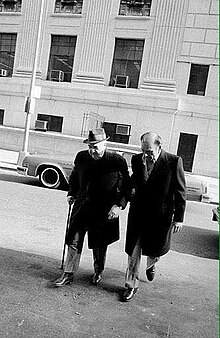Vincent Cafaro (born August 27, 1933) is a former Italian-American mobster who was a soldier in the Genovese crime family under the tutelage of acting boss Anthony "Fat Tony" Salerno, until becoming a government confidential informant and cooperating witness in 1986.
Vincent Cafaro | |
|---|---|
 Cafaro with Anthony Salerno, February 1985 | |
| Born | August 27, 1933 Gambugliano, Kingdom of Italy |
| Other names | The Fish |
| Occupation | Mafia Soldier |
| Allegiance | Genovese crime family |
Labor racketeer
editCafaro was born in the small town of Gambugliano near Vicenza, Italy, but grew up in the East Harlem section of New York, United States. In 1974, Cafaro became a made man, or full member, in the Genovese family and was assigned to Salerno's crew, based out of the Palma Boys Social Club in East Harlem.
From 1974 to 1986, Cafaro was influential in the N.Y.C. District Council of Carpenters rackets. Cafaro received payoff money from fellow East Harlem native and Genovese captain Vincent DiNapoli. DiNapoli's top associate, Teddy Maritas, was President of the District Council. Cafaro's representative in the Carpenters Union was Onofrio "Frankie Zip" Acramone. Cafaro would have Acramone set up meetings with other union officers to gain further influence in the union. Cafaro and Acramone worked with DiNapoli's representatives Attilio Bitondo, Anthony Fiorino, and Gambino crime family representative Carmine Fiore on labor rackets during the construction of the Javits Convention Center in Manhattan.
DiNapoli eventually went to prison for labor racketeering; Maritas disappeared after being indicted. While DiNapoli was in prison, he learned that Cafaro was gaining influence in the District Council. Worried about his turf, DiNapoli took the problem to boss Salerno. Salerno sided with DiNapoli and forced Cafaro to return the union rackets to DiNapoli.
Government informant
editOn March 21, 1986, Cafaro and 14 other mobsters were indicted on federal racketeering charges involving concrete supply companies.[1] In September 1986, while in jail awaiting trial, Cafaro contacted the government about becoming a government informant and witness. In October 1986, the government released Cafaro on bail. From October 1986 to March 1987, Cafaro attended family meetings wearing a recording device. On March 20, 1987, the government revealed in court that Cafaro was now working for them.[2][3] Cafaro's son Thomas was indicted at the same case, and the government offered him a plea agreement also. However, Thomas decided to plead guilty and go to prison to assure the Genovese family that he was still loyal.
Cafaro later testified about the Genovese family involvement in large scale labor racketeering; their control over the New York District Council of Carpenters; and the family's organizational structure. Cafaro also exposed the Genovese family's control over the New York Coliseum and the Javits Center. He also described how Salerno, after suffering a stroke, became a figurehead for new boss Vincent "The Chin" Gigante. This maneuver helped deflect law enforcement scrutiny of Gigante's affairs.[4] When Salerno was eventually convicted and sentenced to 100 years in prison in the Commission case, the real family boss, Gigante, was still free.
In October 1987, Cafaro told prosecutors that he was breaking his cooperation deal because of fear for his immediate family. On February 20, 1988, Cafaro refused to answer some questions in court during a drug trial for Liborio Bellomo and three other defendants.[5] In 1989 and 1990, Cafaro testified against Gambino boss John Gotti and then disappeared into the federal Witness Protection Program.
References
edit- ^ Lubasch, Arnold H. (March 22, 1986). "Reputed Mob Leader Among 15 Indicted on Racketeering Counts". The New York Times. p. 1. Retrieved July 17, 2024.
- ^ "La Cosa Nostra – State of New Jersey Commission of Investigation 1989 Report – The Genovese/Gigante Family". mafianj.com. Retrieved July 17, 2024.
- ^ Lubasch, Arnold H. (March 21, 1987). "Major Mafia Leader Turns Informer, Secretly Recording Meetings of Mob". The New York Times. p. 31. Retrieved July 17, 2024.
- ^ "The Puppet Boss" American Mafia.com November 2001
- ^ Lubasch, Arnold H. (February 20, 1988). "Informer Shuns Pact At Hearing". The New York Times. p. 31. Retrieved July 17, 2024.
Further reading
edit- Goldstock, Ronald, Martin Marcus and II Thacher. Corruption and Racketeering in the New York City Construction Industry: Final Report of the New York State Organized Crime Task Force. New York: NYU Press, 1990. ISBN 0-8147-3034-5
- Jacobs, James B., Coleen Friel and Robert Radick. Gotham Unbound: How New York City Was Liberated from the Grip of Organized Crime. New York: NYU Press, 2001. ISBN 0-8147-4247-5
- Jacobs, James B., Christopher Panarella and Jay Worthington. Busting the Mob: The United States Vs. Cosa Nostra. New York: NYU Press, 1994. ISBN 0-8147-4230-0
- Jacobs, James. Organized Crime and Its Containment: A Transatlantic Initiative. Lieden, Netherlands: Brill Academic Publishers, 1991. ISBN 90-04-08551-3
- Paoli, Letizia. Mafia Brotherhoods: Organized Crime, Italian Style. New York: Oxford University Press, 2003. ISBN 0-19-515724-9
- Raab, Selwyn. Five Families: The Rise, Decline, and Resurgence of America's Most Powerful Mafia Empires. New York: St. Martin Press, 2005. ISBN 0-312-30094-8
External links
edit- United States of America v. Vincent Cafaro and the District Council of New York City and Vicinity of the United Brotherhood of Carpenters and Joiners of America, United States Southern District Court of New York
- United States of America v. Anthony Salerno and Vincent Cafaro, United States Court of Appeals for the Second Circuit